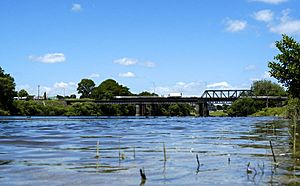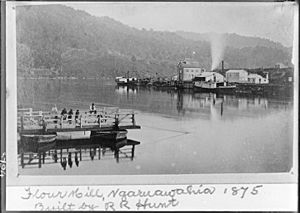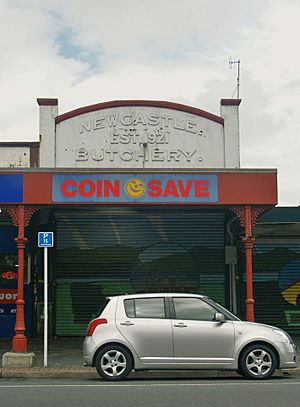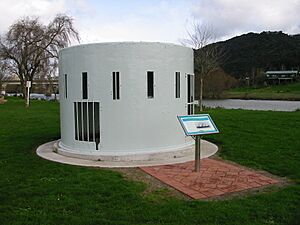Ngāruawāhia facts for kids
Quick facts for kids
Ngāruawāhia
|
|
|---|---|
|
Town
|
|

Waikato River passing through Ngāruawāhia
|
|
| Country | New Zealand |
| Region | Waikato |
| District | Waikato District |
| Ward | Ngaruawahia Ward |
| Community | Ngaruawahia Community |
| Electorates |
|
| Area | |
| • Territorial | 11.86 km2 (4.58 sq mi) |
| Population
(June 2023)
|
|
| • Territorial | 8,170 |
| • Density | 688.9/km2 (1,784.2/sq mi) |
| Time zone | UTC+12 (NZST) |
| • Summer (DST) | UTC+13 (NZDT) |
Ngāruawāhia (Māori pronunciation: [ŋaːɾʉaˈwaːhia]) is a town in the Waikato region of New Zealand's North Island. It is about 20 km north-west of Hamilton. The town sits where the Waikato River and Waipā River meet. It is also next to the Hakarimata Range. Ngāruawāhia is part of the Hamilton Urban Area. This is the fourth largest urban area in New Zealand. Long ago, this spot was even thought of as a possible capital city for New Zealand.
Contents
Discover Ngāruawāhia: People and Place
Ngāruawāhia covers about 11.86 square kilometers. As of June 2023, it has an estimated population of 8,170 people.
Who Lives Here? A Look at the Population
| Historical population | ||
|---|---|---|
| Year | Pop. | ±% p.a. |
| 2006 | 5,334 | — |
| 2013 | 5,364 | +0.08% |
| 2018 | 6,621 | +4.30% |
In 2018, Ngāruawāhia had 6,621 people living there. This was a big increase of 23.4% since 2013. There were 1,962 homes. The town had slightly more females than males. About 28.9% of the people were under 15 years old.
The people of Ngāruawāhia come from different backgrounds. About 54.2% are European/Pākehā. Around 58.7% are Māori. There are also Pacific peoples (5.9%) and Asian people (3.1%). Some people identify with more than one background.
Most people (53.5%) said they had no religion. About 30.4% were Christian. Some (6.1%) followed Māori religious beliefs.
Ngāruawāhia's Rich History
The Town's Original Name and Meaning
The name Ngāruawāhia means "the opened food pits." This name comes from a big feast held in the 1600s. A chief named Te Ngaere and a woman named Heke-i-te-rangi had run away together. They settled in Ngāruawāhia. This caused problems between their tribes.
When their first child was born, Ngāti Maniapoto were invited to a celebration. This was an effort to make peace between the tribes. Te Ngaere's father named the boy Te Mana-o-te-rangi. This honored the Ngāti Maniapoto tribe. Peace was made, and Te Ngaere shouted "Wāhia ngā rua" (break open the food pits).
Key Events: Invasion and Name Changes
In 1863, during the Invasion of the Waikato, General Cameron's forces entered Ngāruawāhia. Māori people had left the town. The Governor did not come to talk peace as promised. Land was taken and sold in 1864.
During the 1800s, Ngāruawāhia was called Queenstown. Then it was called Newcastle. But in 1878, the town went back to its original Māori name.
Ngāruawāhia in the 20th Century
In 1913, a gas power station was built for lighting. It used coal to make gas. This station closed in 1924. Later, the building became a scout hall.
During World War II, soldiers from the United States visited Ngāruawāhia. They shared food at traditional hāngī feasts. Queen Elizabeth II visited the town twice, in 1953 and 1974. On her second visit, the Māori Queen, Dame Te Ātairangikaahu, welcomed her to the local marae.
In 1973, The Great Ngaruawahia Music Festival took place. Many famous bands played there, like Black Sabbath and Split Enz. It was New Zealand's first big outdoor music festival.
In 1998, a freight train went off its tracks. This happened on the rail bridge over the Waikato River. The bridge was damaged.
Water Supply for the Town
Before 1923, people got water from springs. In 1923, a new water system opened. It got water from a dam in the Hakarimata mountains. The dam is 100 feet long and 26 feet high. You can still visit it today. By 1965, the town needed more water. So, water was pumped from the Waikato River and a deep well. A new water treatment plant opened that year.
Ngāruawāhia in the 21st Century
By April 2001, the damaged rail bridge was fixed. In 2008, Ngāruawāhia set a world record. They performed the largest haka ever. By 2010, the town had its own community news.
In 2011, new murals were put up for the town's 150th anniversary in 2013. Ngaruawahia High School also celebrated its 50th anniversary in 2013.
In 2016, a broadcaster said the town was "rotting." The local mayor, Allan Sanson, said this upset the people. The broadcaster later visited the town and apologized. In 2019, the town's name was officially spelled Ngāruawāhia.
Getting Around: Bridges and Transport
Crossing the Waikato River

Long ago, rivers were the main way to travel. But after roads and railways were built, rivers became obstacles. People needed ways to cross them.
For many years, a punt (a flat-bottomed boat) carried people and goods across the river. In 1876, a bridge for both roads and trains opened. At first, there were not many trains. But by the 1900s, more cars and trains were using the bridge.
The 1921 Road Bridge
People wanted a separate road bridge for a long time. Work on a new road bridge started in 1917. It faced delays due to wartime shortages. The bridge finally opened in 1921. It was 12 feet wide and 436 feet long. It was made of strong wood and concrete.
This bridge was only one lane wide. This caused problems as traffic grew. So, in 1931, it was changed to allow two-way traffic.
The 1956 Modern Bridge
A contract for a new, wider steel bridge was signed in 1953. This new bridge opened on October 19, 1956. By 2008, over 17,000 vehicles crossed this bridge every day. Later, a new highway link opened. This reduced the traffic on the Ngāruawāhia bridge.
Historic Buildings to See
Ngāruawāhia has many historic buildings. They show the town's past.
- Turangawaewae House: Built between 1912 and 1919. It mixes traditional Māori styles with the Arts and Crafts movement.
- Other notable buildings: These include the Band Rotunda, Delta Tavern, and the old Newcastle Butchery building. You can also see the Pioneer Gun Turret and St Paul's Church. The former Māori pā site, Puke i Ahua, is also a historic spot.
Community Life in Ngāruawāhia
The Māori King Movement
Ngāruawāhia is the home of the Kīngitanga. This is a very important part of Māori culture. The first Māori King, Pōtatau Te Wherowhero, was crowned here in 1858. He lived here until he passed away. The current Māori Queen is Ngā Wai Hono i te Pō. She became Queen at Tūrangawaewae Marae after her father passed away in 2024.
Marae: Important Meeting Places
Ngāruawāhia has two main marae. These are special meeting places for Māori people. They are connected to the Waikato Tainui tribes of Ngāti Mahuta and Ngāti Te Weehi.
- Tūrangawaewae Marae: This marae has the Mahinaarangi or Turongo meeting house.
- Waikeri-Tangirau Marae: Another important marae in the town.
Community Support and Groups
A local group called Tribal Huk has helped the community. They have provided lunches for schoolchildren in Ngāruawāhia and nearby towns. They are sometimes called the "Sandwich Gang" because of this.
There have been community meetings about local issues. In November 2016, another community meeting was held to discuss these matters.
Christianity in Ngāruawāhia
In the 1996 census, most people in Ngāruawāhia identified as Christian. A Bible is often used when a Māori monarch is crowned. The Holy Trinity Anglican Church burned down in 1995. A new church was built in its place by 1998.
On the north side of the Waipā River is the Christian Youth Camps (CYC). This is the largest youth camp in New Zealand. It started in the 1960s. Today, it has two camp sites on a large area of land. The camp offers holiday programs for kids. During school terms, many groups use the camps. These include schools, churches, and sports teams.
Sports and Fun Activities
Football (Soccer)
Ngaruawahia United is the local football (soccer) club. They are known as "The Green Machine." The club started in 1968. Their home ground is Centennial Park.
Rugby League
The town has two rugby league teams: Ngaruawahia Panthers and Tūrangawaewae. The Ngaruawahia Rugby League Club is the oldest in the Waikato region. They played their first major game in 1911. The senior team won championships in 1956 and 1957.
The Turangawaewae RLC team is named after the marae. They hold a record for winning the Waicoa Bay Premiers Competition two times in a row. The Ngaruawahia Rugby League Club (Panthers) were champions in 2011.
River Fun: Regatta and More
The local regatta is a very old and important event. It happens every year in March on the Waikato River. The first unofficial regatta was in 1892. It brought Māori and Pākehā people together. The first official regatta was in 1896. It has grown to be one of New Zealand's biggest water festivals. In 1996, over 48,000 people visited the town for the centennial regatta.
For many years, jumping off the rail bridge has been a tradition. However, groups like KiwiRail want people to stop doing this for safety reasons.
Hopuhopu: A Place of History and Learning
Hopuhopu is about 5 km north of Ngāruawāhia. In 1853, there was a boys' mission school here. It closed in 1863. Later, in the 1920s, an army camp was built on the same site. It had its own water supply and a railway line.
In 1993, the army camp land was given back to Waikato-Tainui. They turned it into their main office. They also built the Waikato-Tainui College for Research and Development there.
Education in Ngāruawāhia
Ngāruawāhia has several schools for students of all ages.
- Ngaruawahia High School: This is a co-educational secondary school. It is for both boys and girls. It has a roll of 231 students as of February 2024.
- Ngaruawahia School: A state primary school teaching in English. It has a roll of 126 students.
- Waipa School: Another state primary school teaching in English. It has a roll of 317 students.
- St Paul's Catholic School: This is a state-integrated primary school. It is also co-educational and has a roll of 98 students.
- Te Kura Kaupapa Māori o Bernard Fergusson: This is a Māori-language state primary school. It is co-educational and has a roll of 165 students.
Famous People from Ngāruawāhia
Many interesting people have lived in Ngāruawāhia, including:
- Kelvin Cruickshank: A well-known television personality.
- Martin Donnelly: A famous cricketer.
- Shaun Kenny-Dowall: A talented rugby league player.
- Inia Te Wiata: An opera singer and traditional carver.
- Richard Tomlinson: A former MI6 officer.
- Dallin Watene-Zelezniak: Another skilled rugby league player.
- Allan Wilson: A respected biochemist.






